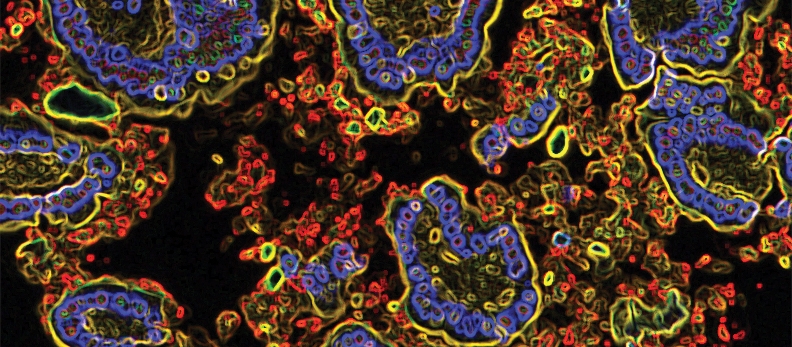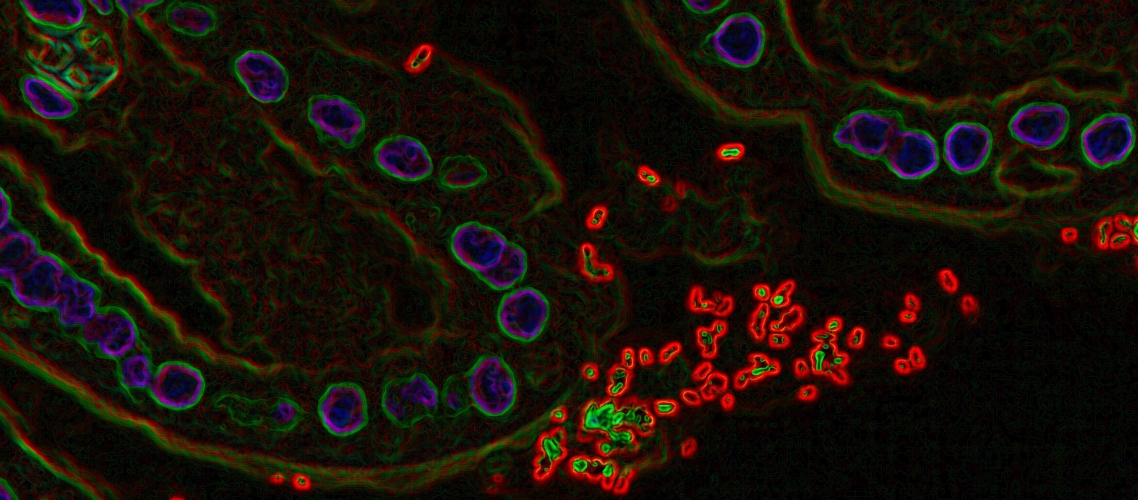
Crohn’s disease bacteria drives arthritis. E. coli bacteria (red), which are abundant in the immunoglobulin-A-coated microbiota of patients with a Crohn’s disease-associated condition called spondyloarthritis, promote systemic inflammation. The blue circular structures depict the nuclei of cells called epithelial cells. All images: Dr. Kenneth Simpson, Cornell University.
Patients with Crohn’s disease, a type of inflammatory bowel disease (IBD) that causes abdominal pain and diarrhea, can also experience joint pain. In Crohn’s disease, which affects about 800,000 Americans, the immune system can attack not only the bowels, but the musculoskeletal system as well, leading to spondyloarthritis, a painful condition that affects the spine and joints. Now new research, published Feb. 8 in Science Translational Medicine, helps explain the connection between these seemingly unrelated symptoms, and could help physicians identify Crohn’s disease patients who are more likely to develop spondyloarthritis, enabling them to prescribe more effective therapies for both conditions.
New technology helped the researchers identify a type of E. coli bacteria found in people with Crohn’s disease that can trigger inflammation associated with spondyloarthritis. The researchers used fecal samples from patients with IBD to identify bacteria in the gut that were coated with antibodies called immunoglobulin-A (IgA) that fight infection. Using flow cytometry, in which fluorescent probes are used to detect IgA-coated bacterial species, the researchers discovered that IgA-coated E. coli were abundant in fecal samples from patients with both Crohn’s disease and spondyloarthritis.
Using both patient samples and mouse models, they then linked these bacteria to cells that help regulate inflammation, known as Th17 cells, in people with autoimmune disorders. “Our findings may allow us to develop diagnostic tools to stratify Crohn’s patients with spondyloarthritis symptoms as well as patients at risk,” said senior author Dr. Randy Longman, assistant professor of medicine and director of the Jill Roberts Institute Longman Lab at Weill Cornell Medicine. Patients with Crohn’s disease and spondyloarthritis had higher levels of Th17 cells, and IL-23 triggers their activity. With the recent FDA approval of an anti-IL-23 medication for Crohn’s disease called ustekinumab, the findings may help physicians select therapies that target symptoms of both the bowels and joints in these patients.

Crohn’s disease bacteria drives arthritis. E. coli bacteria (red), which are abundant in the immunoglobulin-A-coated microbiota of patients with a Crohn’s disease-associated condition called spondyloarthritis, promote systemic inflammation. The blue circular structures depict the nuclei of cells called epithelial cells. All images: Dr. Kenneth Simpson, Cornell University.
“Just sequencing the gut flora gives you an inventory of the bacteria, but does not tell you how they are perceived by the host immune system,” said Dr. Kenneth Simpson, professor of small animal medicine at Cornell’s College of Veterinary Medicine whose laboratory characterized the E. coli identified in the study. “This approach is giving you a functional readout versus just an inventory.”
“We knew there was smoke but we didn’t know where the fire was,” said Dr. Simpson. “If we can block the ability of bacteria to induce inflammation, we may be able to kick Crohn’s disease and spondyloarthritis into remission.” “In IBD therapy, this is a step toward precision medicine – to be able to clinically and biologically characterize a subtype of disease and then select the medicine that would best fit the patient with this type of inflammation,” Dr. Longman added. “The results of this innovative study will start to inform our decision of which of our available medications will give the best chance of helping the individual patient.” http://news.weill.cornell.edu/news/2017/02/research-uncovers-bacteria-linking-crohn%E2%80%99s-disease-to-arthritis








Recent Comments